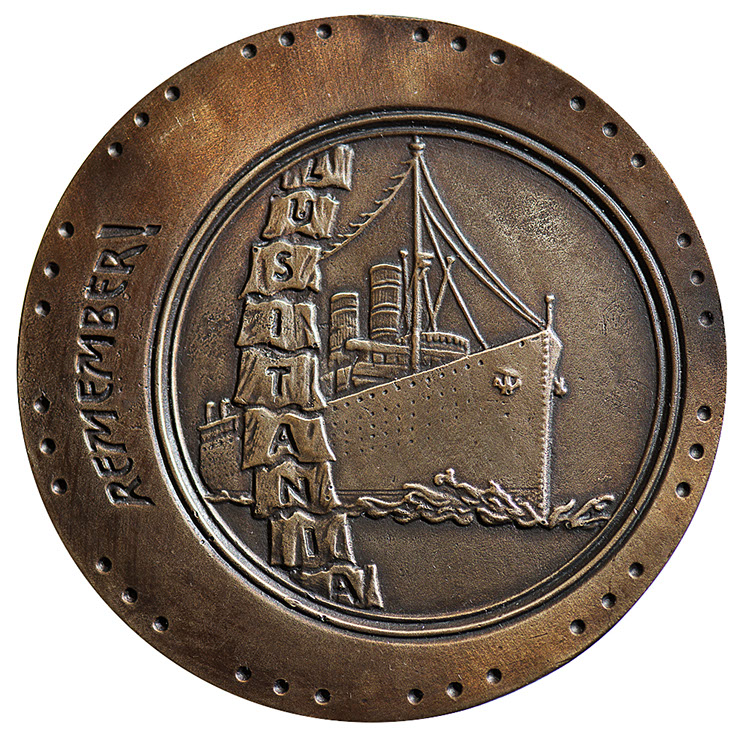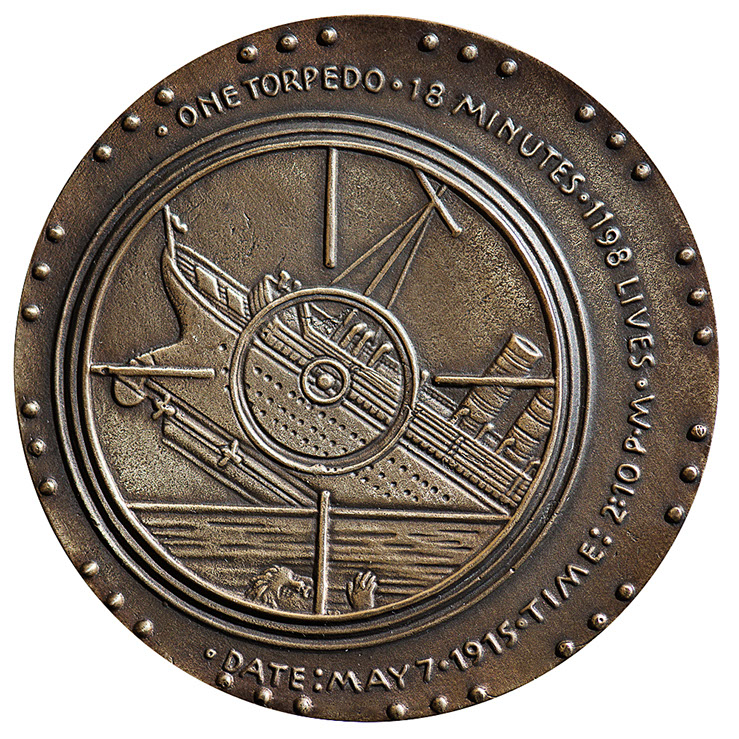
Greg Burns currently serves as editor of The California Numismatist, the award-winning joint publication of the California State Numismatic Association (CSNA) and the Numismatic Association of Southern California (NASC), and has been a coin collector for about 35 years. His collecting passions are the satirical medals of the German medallist, Karl Goetz, medals relating to WWI in general, and he has a longtime fascination with Canadian colonials and bank tokens.

Anniversary Medal
May 8, 2915 - Sorry to say the project is at this time complete, and without a commercially-viable product. Over the course of the last three years many hours of effort have gone into its design and production. There were in total three trials in bronze alloy as noted following:
Trial Description, Size, Weight, Quantity Produced, Quantity Released
1: Die-struck, 2.5” diameter, 4.6 ounces, 40, 36
2: First casting, 3.44” diameter, 9.2 ounces, 2, 0
3: Second casting, 3.3” diameter, 7.4 ounces, 32, 29
None of the three trials met my standards for quality. My chief complaints were: the die-struck pieces’ dies were cut too shallow, and I did not care for the outlining treatment of the sinking ship; the first casting’s reverse is rotated 30 degrees, though the casting quality was reasonably good; the second castings reverse is rotated 30 degrees, but in the opposite direction from the first casting, and the quality of the casting workmanship ranged from poor to mediocre at best. Having failed to produce what I considered a commercially viable and esthetically acceptable piece by my self-imposed deadline of the 100th anniversary of the sinking on 7 May 2015, I dropped this production plan entirely.
Even though the initial production plan didn’t turn out to meet my quality standards, I couldn’t bring myself to simply destroy the pieces, and so I offered them for sale to an email list I maintain of select individuals interested in the story of the Lusitania as at least a memento of my attempts. Once the trial pieces are sold there will only be the secondary market as an option for anyone wishing to acquire one, as I will not be producing any more from these dies or molds for commercial sale.
The sculptor of the design is Alex Shagin. The obverse of the medal shows the cheery Lusitania confidently steaming along, flags spelling out her name fluttering in the sea breeze, as viewed through a porthole device which shares the rim with the often quoted phrase of the coming dread occasion, “Remember!” (well, often quoted during WWI recruitment and propagandizing efforts anyway). The reverse of the medal shows the stricken liner as though viewed through the periscope of the U-20, the German unterseeboot which fired the fateful torpedo which struck the ship at 2:10PM, sinking it in an astoundingly quick 18 minutes. The rim inscription repeats the significant facts: “one torpedo, 18 minutes, 1198 lives” and the date and time of the somber event.
Die-struck pieces while they last are $60 each plus $5 shipping to USA addresses.
Second casting pieces while they last are $85 each plus $5 shipping to USA addresses.


February 2015 - We seem to have found a foundry that is acceptable. I've purchased bullion silver for when we cast those, and the foundry can supply the bronze. I'm hoping to have initial pieces in bronze within the next few weeks. We'll see. This is taking lots longer (and is more "exciting") than I first anticipated. Well, they say that anything worthwhile takes effort, and if so, then these should be beauties. I'll post more when I have something in hand, and hopefully include some photos.
December 2014 - The first attempt was a complete failure. If/when I produce a second edition of the book (actually, I should turn my mind to that now), I'll go into that in more depth, mostly because I think it's an interesting story for people interested in the mechanics of medallic art. But, that's okay. The quality of the struck pieces was completely unacceptable, and I learn from my mistakes (mostly). The designer and I fretted over the past year, explored a number of options, and just in the last month or two have had a successful next attempt. We're about three-quarters of the way through the steps necessary to produce a much nicer cast piece (instead of struck). I've seen the two prototypes (two uniface pieces, one for the obverse and one for the reverse), and they're both beautiful. The designer reworked the plaster models (actually remade them entirely) incorporating some esthetic changes that, in my opinion, made a huge difference. The new cast pieces are larger and much more esthetically pleasing. We've been discussing the order quantity and alloys (bronze and silver... be still my beating heart), and are preparing for initial production of what I hope will be the final version suitable for sale. I'll let you know when I have something that meets our joint standards, and provide high-resolution photos as well as pricing/ordering information at that time.
September 2013 - Well, I've paid for dies and had a small trial run of the medals produced. The good news is that I still love the design concept. The bad news is I consider the esthetic quality of the dies and resulting strikes completely unacceptable. They're far too shallow for me to consider any significant production. The event is worthy of a fitting commemoration, and I'll have to pursue another course to make it happen from a medalic standpoint. I've been talking with the designer about various production options, but am stymied for the moment. I'll let you know if and when I figure something out <sigh>...
February 2013 - Watch this page for information about the anniversary medal now in the design phase. I've been working with an internationally recognized medallic artist and sculptor, and the design concept and initial models are complete. We're just making some minor revisions and will be cutting dies shortly. I wouldn't be surprised to have an initial trial run complete during the first quarter of 2013.